Mazda attacks the three-row family hauler SUV segment using know-how straight from its sports car playbook.

Mazda is seeking to solidify its position as the enthusiast’s carmaker with a redesign of its three-row family hauler that applies some of the magic from the MX-5 Miata that the company used to call “zoom-zoom.”
In this case, it means a shift from a front-drive platform to a rear-drive design and the introduction of an inherently balanced inline six-cylinder engine. To these ingredients, Mazda adds the torque converter-free automatic transmission technology seen previously on other models for the added responsiveness and efficiency of a computer-controlled clutch in place of a torque converter.
The CX-90 also employs sports car suspension design and geometry that debuted on the Miata sports car to give drivers added control and precision when piloting this SUV.
The combination of these ingredients promises to deliver a driver’s car, despite the CX-90’s family-hauling eight seats.
Power comes from Mazda’s 340 horsepower and 369 lb-ft of torque e-Skyactiv G 3.3L Inline 6 Turbo engine, which has the highest horsepower and torque from a mass production gasoline engine developed by Mazda. The combustion engine is equipped with 48-volt mild hybrid M-Hybrid Boost system for improved efficiency and response. The hybrid-electric motor is mounted between the engine and transmission, contributing to smooth acceleration and allowing the electric motor to directly power CX-90 at low speed.
The optional plug-in hybrid drivetrain is based on Mazda's 2.5-liter four-cylinder engine. In combination with the electric motor, this drivetrain produces 323 horsepower and 369 lb-ft of torque. The 17.8 kilowatt-hour battery pack provides 26 miles of electric-only driving range.
Both powerplants are matched to Mazda’s new eight-speed automatic transmission, which the company designed and manufactures in house to be as compact as possible, so that the rear-drive transmission hump intrusion into the front seat footwells is minimized. While it is a conventional planetary automatic transmission, as on other Mazdas, the torque converter has been replaced by a computer-controlled clutch pack, which reduces efficiency losses and provides snappier response to throttle input.
CX-90’s suspension includes Mazda’s Kinematic Posture Control (KPC), which first debuted on the MX-5 Miata. This system employs software that suppresses body lift on tight corners to enhance the grip and allows all occupants to maintain a natural posture. KPC works in conjunction with the geometry of the suspension, which includes properties that assist in keeping the vehicle flat when cornering, accelerating, or braking.
![2023_CX-90_Platform_PHEV_AWD[1].jpg 2023_CX-90_Platform_PHEV_AWD[1].jpg](https://eu-images.contentstack.com/v3/assets/blt0bbd1b20253587c0/blt1cbc7ceed269429b/64f9e5a0ba8c26919f2ccfd7/2023_CX-90_Platform_PHEV_AWD_5B1_5D.jpg?width=700&auto=webp&quality=80&disable=upscale)
The vehicle’s front suspension is a double wishbone design, which has numerous dynamic advantages over the cheaper, more typical McPherson strut design used on most vehicles. “As the body rolls and compresses the outside suspension, the double wishbone suspension automatically pulls the top of the tire in, keeping the tire upright as the body rolls around it,” explained Dave Coleman, manager of vehicle dynamics at Mazda R&D. “This gives us the maximum front grip.”
Meanwhile, the five-link rear suspension’s geometry is optimized to exploit the movement of the wheel through the suspension stroke. “The most critical point here was establishing the appropriate amount of anti-squat to deal with the high-output powertrain,” Coleman said. “Links are arranged to make the wheels swing around a virtual pivot point such that the wheels move backward slightly when the wheel moves up (under compression) and forward a little bit when the wheel moves down (under extension). This helps when you hit a bump, because when you hit a bump it pushes the wheel back and will naturally make the wheel want to move up.”
This design not only benefits cornering, but also control during acceleration and braking. “Under acceleration, weight shifts onto the rear tires, making the rear suspension squat,” noted Coleman. “But the force accelerating the car is pushing through this virtual pivot point, pushing the wheels forward, which makes them want to push down. So this pushes the body back up and resists that acceleration squat a little bit. This same geometry also gives us an anti-dive effect under braking.”
![2023_Mazda_3.3L_Engine_See-through[1].jpg 2023_Mazda_3.3L_Engine_See-through[1].jpg](https://eu-images.contentstack.com/v3/assets/blt0bbd1b20253587c0/blt8eabc10a005833c4/64f9e5a1acd06f0d4f1093c4/2023_Mazda_3.3L_Engine_See-through_5B1_5D.jpg?width=700&auto=webp&quality=80&disable=upscale)
With this mechanical action at work, Mazda’s engineers sought to maximize the benefit with the input of some software too. “We’ve taken advantage of this geometry by developing a unique body control algorithm called Kinematic Posture Control,” Coleman said. “In a corner, KPC applies a tiny amount of brake force, just to the inside rear tire. Thanks to the anti-dive geometry, the braking force pulls down on the inside rear corner of the car a little bit, slightly reducing body roll, pitch forward, and heave, where the whole body moves up and down. This really improves platform stability and helps the car naturally and precisely follow the driver’s intended path.”
We won’t know how well the CX-90 delivers on the promise of its engineering, but Mazda has a record of success in the area of vehicle dynamics that leads us to be optimistic. It will also be interesting to experience its hybrid-electric drivetrain calibration in the real world. More to come on that.
About the Author(s)
You May Also Like





